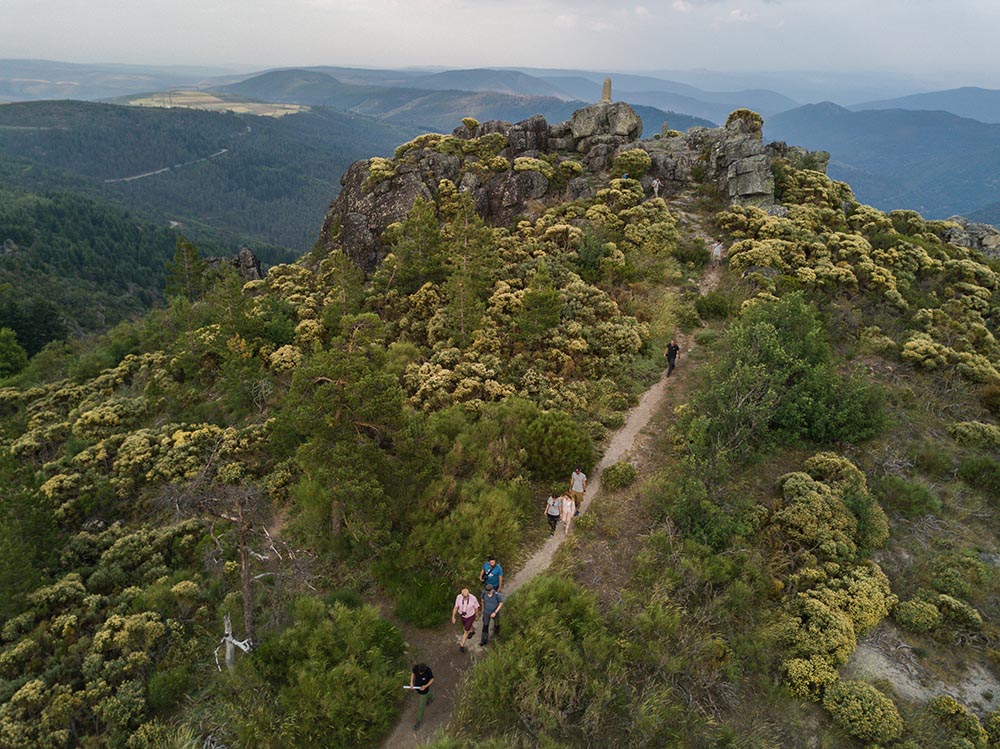Celebrating Earth Heritage
 The Estrela Geopark, located in Central Portugal, has an area of 2216km2 distributed among nine municipalities, with almost 170000 inhabitants. The main towns inside the geopark are Guarda, Covilhã and Seia, all with higher education institutions. The boundaries are approx. 40°42'7"N, 7°15'28"W in the NE and 40°7'4"N, 7°44'24"W in the S. The position of the geopark is of territorial advantage for tourism, at 44 km from Spain (371 km to Madrid), and with excellent connections to large Portuguese cities (e.g. Lisbon - 276 km, Oporto - 160 km and Coimbra - 76 km). The EAG includes the Estrela mountain range from its SW limits at the border with the Açor mountain, to the NE contact with the Meseta surface, as well as the piedmont regions that bound the Estrela to the NW and SE. The altitudes vary from around 200 m in the Alva valley to 1993 m at the Alto da Torre. The climate is Mediterranean, with dry and warm summers, with annual precipitation over 2500 mm in the summit areas, making the geopark a strategical source of drinking water for all Central Portugal. The Geopark is a low-density territory with ageing population, low level of education and a desegregation of the traditional economic structure marked by the strong rural exodus. The main employment areas are tourism, education and public administration, textile industry nd agriculture and animal production. The territory has a good network of tourism, transport, cultural and health facilities.
The Estrela Geopark, located in Central Portugal, has an area of 2216km2 distributed among nine municipalities, with almost 170000 inhabitants. The main towns inside the geopark are Guarda, Covilhã and Seia, all with higher education institutions. The boundaries are approx. 40°42'7"N, 7°15'28"W in the NE and 40°7'4"N, 7°44'24"W in the S. The position of the geopark is of territorial advantage for tourism, at 44 km from Spain (371 km to Madrid), and with excellent connections to large Portuguese cities (e.g. Lisbon - 276 km, Oporto - 160 km and Coimbra - 76 km). The EAG includes the Estrela mountain range from its SW limits at the border with the Açor mountain, to the NE contact with the Meseta surface, as well as the piedmont regions that bound the Estrela to the NW and SE. The altitudes vary from around 200 m in the Alva valley to 1993 m at the Alto da Torre. The climate is Mediterranean, with dry and warm summers, with annual precipitation over 2500 mm in the summit areas, making the geopark a strategical source of drinking water for all Central Portugal. The Geopark is a low-density territory with ageing population, low level of education and a desegregation of the traditional economic structure marked by the strong rural exodus. The main employment areas are tourism, education and public administration, textile industry nd agriculture and animal production. The territory has a good network of tourism, transport, cultural and health facilities.
© Filipe Patrocínio
Sustaining local Communities
The Estrela UNESCO global Geopark geological history dates back to the Neoproterozoic, with the Douro-Beiras Super Group, a thick terrigenous sequence dominated by turbidites. The Variscan orogeny deformed these metasediments, affected by the intrusion of granitic batholiths in late orogenic stages. At the end of the Variscan, the relief was planated and later retouched during the Paleogene. In the Miocene, Variscan faults were reactivated, resulting in the uplift of the Serra da Estrela as a pop-up structure, forming a plateau mountain. The plateau and its altitude close to 2000 m are key for the development of the features that lead to the geological significance of the EAG - the glacial landforms and deposits - resulting from its interaction with Pleistocene climate variability. During Pleistocene glacials, the Estrela developed a plateau ice-field,which was extremely sensitive to variations in glacier palaeo-equilibrium line altitude. The results were the formation of extensive glacial erosion landforms and deposits, very remarkable considering the geographical setting of the Estrela in Central Portugal. The interaction of the glaciers with the inheritance from the long geological history, such as deep weathering mantles, and the interplay of climate and active tectonics add-up to the scientific value of the EAG. The most relevant geosites are the: the Lagoa Seca moraine field, the Covão do Boi granite columns, and the Zêzere glacial valley.
Contact
-
Emanuel de Castro emanuelcastro@geoparkestrela.pt
